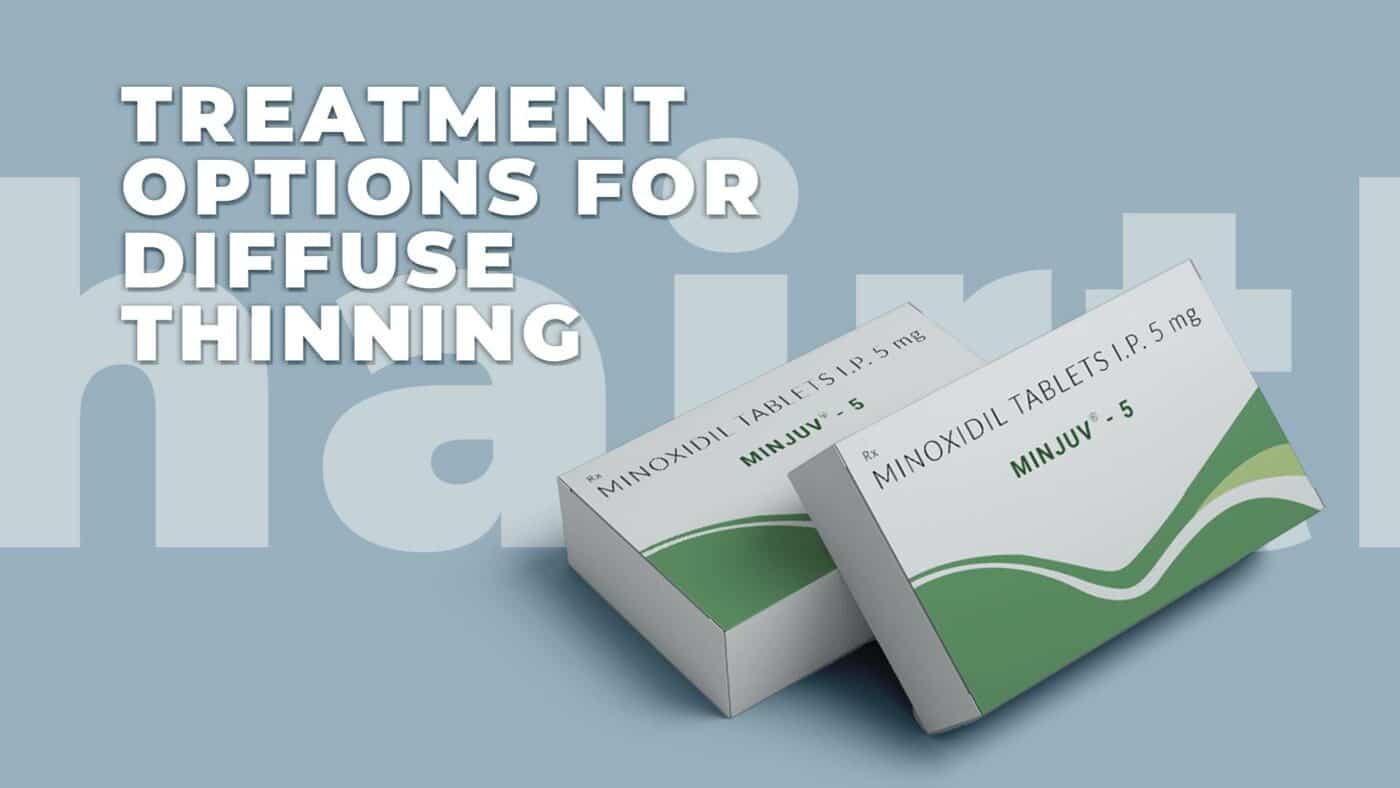Diffuse Thinning Hair: Causes and Treatment Options

It’s widely known that hair loss, including shedding and overall loss of hair, is a prevalent condition that affects both men and women. The causes of this issue are diverse and complex, and diffuse thinning hair loss is no exception.
There are various forms of hair loss, ranging from a receding hairline to a bald patch that can develop near the crown of your head. One of the most prevalent types is diffuse thinning, which affects the entire scalp and gives the appearance of thin, translucent hair instead of affecting only specific areas like the hairline or crown. Diffuse thinning can be caused by various factors, including androgenetic alopecia (also known as male pattern baldness) and temporary hair shedding due to medical conditions.
In this article, we’ll define diffuse thinning and discuss the common signs of this type of hair loss. We’ll also explore the typical causes of diffuse thinning and suggest steps you can take to promote hair growth and restore your hair’s normal thickness and density.
Table of Contents
What is Diffuse Thinning?
Diffuse hair loss or diffuse thinning is characterized by hair loss from all regions of the scalp, leading to an overall reduction in hair density and a thinner appearance of hair. Male pattern baldness, the most prevalent cause of hair loss in men, usually begins with a bald spot at the crown or a receding hairline.
Conversely, diffuse thinning affects the entire scalp uniformly, without any distinct pattern of hair loss. As with other types of hair loss, diffuse thinning can significantly impact the appearance of hair and one’s overall well-being.
Causes of Diffuse Thinning

Diffuse thinning can be caused by various factors. Below are some of the most common causes of hair loss that can lead to diffuse thinning:
- Telogen effluvium: Diffuse thinning is commonly associated with a condition called telogen effluvium, which can be triggered by various factors such as stress, trauma, hormone fluctuations, thyroid problems, medications, and nutrient deficiencies. Aside from hair thinning, telogen effluvium may also cause bald patches and shedding of visible hair clumps during showering or brushing. This condition occurs when anagen (growth) hairs enter the telogen (shedding) phase prematurely. It usually takes some time for the hairs to transition and shed, and telogen effluvium is generally temporary and reversible with proper treatment.
The following factors are commonly associated with triggering TE:
- Hormonal changes, such as those occurring during pregnancy, after childbirth, or when stopping oral contraceptives.
- Stress, can cause TE to develop 2-3 months after experiencing extreme stress.
- Illness or trauma, such as fevers, COVID-19, invasive surgery, or accidents.
- Weight loss, including rapid or extreme weight loss and crash diets.
- Changes in diet, such as caloric, fatty acid, or protein restrictions.
- Deficiencies in vitamins or minerals, including zinc, vitamin D, selenium, and iron deficiency.
- Endocrine imbalances, such as hyperthyroidism or hypothyroidism.
- Medications, such as beta-blockers, ACE inhibitors, anticoagulants, androgens, retinoids, and antidepressants.
- Poisoning, including exposure to arsenic, mercury, thallium, lead, or cadmium.
- Age: Another frequent cause of diffuse thinning is ageing. Although hair loss may be normal during younger years, age-related thinning is inevitable. Some people choose to seek treatment for age-related thinning, while others choose to accept and embrace it. Both choices are valid and up to the individual.
- Androgenic alopecia: Male pattern baldness, also known as androgenic alopecia, affects around 50% of men over the age of 50 and can be hereditary. It is associated with androgens, male sex hormones that regulate hair growth. As male pattern baldness progresses, visible diffuse thinning becomes more likely, according to the Norwood Scale. Female pattern baldness is also hereditary and affects the scalp and part line. As it progresses, it may result in diffuse thinning across the entire scalp, as classified by the Ludwig Scale.
- Anagen effluvium: It is a form of hair loss that can occur due to severe trauma, such as medication with high toxicity or harsh medical treatments like chemotherapy. It causes hair loss across the entire scalp, weakening the hair and making breakage more likely. However, this condition is usually reversible, and hair can grow back once treatment has ceased.
- Alopecia areata incognita: It is a type of alopecia areata that can cause sudden hair shedding and diffuse thinning, with changes appearing within weeks. In contrast, diffuse alopecia areata occurs over a longer period of time and usually involves widespread thinning, eventually affecting the whole scalp.
Diffuse thinning can also be caused by female pattern hair loss when discussing hair loss in women. This type of hair loss usually begins around the scalp and part line, which is where the hair splits into a left-facing and right-facing natural hairline, and can progress to diffuse thinning across the scalp.
While diffuse hair thinning is a common symptom of female pattern hair loss, it is not the primary factor used to diagnose this condition.
Signs of Diffuse Thinning
Diffuse thinning can manifest suddenly or gradually over several months, similar to other forms of hair loss. If you are experiencing this type of hair loss, there are certain signs and symptoms to look out for, such as
- Reduced hair density: When experiencing diffuse hair loss, a notable indication is visibly thinning hair, which appears less dense than usual and has fewer hairs at the hairline, mid-scalp, and crown.
- Visible scalp: As hair density decreases, the scalp may become more visible, particularly when viewed under bright, downward-facing light or when wet.
- Excessive shedding: Another symptom of diffuse hair loss is excessive hair shedding, which can exceed the typical 50 to 100 daily hair loss due to natural growth cycles. This excessive shedding may result in numerous hair strands visible on bedding, shower drains, or pillowcases.
Diagnosis
If you are experiencing hair loss without explanation, getting a proper diagnosis is crucial as it could reveal an underlying medical condition such as hypothyroidism. When consulting with a healthcare provider, you can anticipate a discussion around several topics such as the timing and amount of hair loss, associated symptoms, general health, recent illnesses, diet, medication and supplement use, haircare practices, major events, stress levels, and family history.
A physical examination and consultation with a dermatologist may involve various diagnostic techniques, including
- the hair wash test,
- hair pull test,
- visual analysis,
- scalp biopsy, and
- laboratory testing.
Laboratory testing may include blood count, iron levels, endocrine system/thyroid function, autoantibodies, various hormone levels, blood sugar, vitamin/nutrient levels, and other medical conditions that may be diagnosed through testing.
Treatment Options for Diffuse Thinning

Medication, lifestyle changes, hair loss products or a combination of different approaches can usually treat diffuse thinning, similar to other types of hair loss. Below, we have discussed some of the most effective ways to treat it.
- The Underlying Condition Should Be Treated First
Telogen effluvium-related diffuse thinning generally improves on its own after identifying and treating the underlying cause of hair loss. This may involve changes in medication or medical treatments, modifications in diet, stress reduction, or simply resting and recovering after an injury or surgery.
If you suspect that you have telogen effluvium, it’s recommended to consult your healthcare provider or schedule an appointment with a dermatologist. They will examine your hair for signs of telogen effluvium using a pull test and biopsy. Many common causes of telogen effluvium can be diagnosed with a complete blood count, thyrotropin test, and other convenient blood tests.
- Minoxidil
Minoxidil is a medication for hair loss that comes in liquid or foam form and is applied topically. It promotes hair growth by shifting hairs into the anagen phase, the growth phase of the hair cycle, and increasing blood supply to the scalp. If you have diffuse hair loss, applying minoxidil to your scalp can stimulate growth and produce thicker, denser hair. In a 12-month study, 84.3 percent of balding men who used minoxidil rated it as effective at promoting hair regrowth.
- Finasteride
Finasteride, on the other hand, is a prescription hair loss medication available in tablet form. It works by inhibiting the effects of 5-alpha reductase, an enzyme responsible for converting testosterone into dihydrotestosterone (DHT). DHT is a hormone that causes male pattern baldness by shrinking hair follicles in the scalp. Finasteride is highly effective for hair loss caused by DHT. A study published in the Journal of the American Academy of Dermatology found that men who used finasteride for two years experienced a 15.8 percent increase in vertex scalp hair count.
- Growth Shampoo
One option for promoting hair growth is using a growth-promoting shampoo. These shampoos often contain ingredients like saw palmetto and ketoconazole that are formulated to strengthen hair growth. They are specifically designed to address the buildup of DHT on the scalp and support other hair loss treatments.
- PRP Therapy
Numerous studies have suggested that platelet-enriched plasma (PRP) can enhance hair growth in individuals experiencing male and female pattern hair loss. The PRP treatment involves drawing a patient’s blood, separating the platelets, and injecting a concentrated platelet solution into the scalp. The process consists of three initial monthly treatments, followed by periodic maintenance treatments every 3-6 months to sustain growth. When combined with topical minoxidil, PRP has shown to produce better outcomes. Nevertheless, further comprehensive studies are necessary to determine PRP’s efficacy in treating hair loss.
- Hair Transplant
Hair transplantation may not be an appropriate option for individuals with diffuse thinning who do not possess dense areas of permanent hair that can be transplanted to bald areas. Those with diffuse androgenetic alopecia who opt for a hair transplant may encounter hair loss if the hair is not extracted from a “safe donor area” of their scalp.
Prevention
Certain types of diffuse thinning may be hereditary and not preventable, but there are still ways to enhance hair health that can aid in preventing many cases of hair loss:
- Avoid frequent harsh chemical hair treatments, heat, and over-styling to safeguard the hair.
- Do not overdose on supplements such as vitamins A, E, and selenium to prevent negative impacts on hair health.
- Maintain a healthy diet rich in protein, vitamins, minerals, and antioxidants to prevent deficiencies that can cause hair loss.
- Collaborate with a healthcare professional to rectify nutritional deficiencies or endocrine imbalances.
- Maintain a healthy weight to promote good hair health.
- Consider scalp massages that can enhance circulation to the scalp and promote healthy hair growth.
- Reduce stress by adopting exercise and good sleep habits, or seek stress-management programs.
- Attend regular annual physicals to monitor potential health issues and work with healthcare providers to keep medical conditions under control.
Various health issues may negatively impact hair health. If you notice diffuse hair loss problems, contact your healthcare provider. Preventing hair loss or follicle damage is much easier than trying to restore hair later on. Even if you do not prioritize having hair, addressing inexplicable hair loss can signify a more severe medical condition.
When to Speak to a Hair Loss Specialist
It is advisable to seek medical advice from your doctor if you experience sudden hair loss or if you’re concerned about the impact of hair loss on your life before taking any steps. After ruling out any underlying issues, you can consider embarking on a hair restoration journey.
Takeaway

Diffuse thinning, which is a condition where hair becomes thin and sparse all over the scalp, can be caused by various forms of hair loss, including telogen effluvium, male pattern baldness, and autoimmune forms such as alopecia areata. The extent and pattern of hair loss may vary depending on the underlying cause. It’s crucial to consult a healthcare provider or dermatologist if you notice your hair thinning abnormally. Treatment options like minoxidil and finasteride can often effectively stop hair loss and prevent diffuse thinning from worsening.
References
- Ho, C.H., Sood, T. & Zito, P.M. (2021, May 5). Androgenetic Alopecia. StatPearls. Retrieved from https://www.ncbi.nlm.nih.gov/books/NBK430924/
- Do You Have Hair Loss or Hair Shedding? (n.d.). Retrieved from https://www.aad.org/public/diseases/hair-loss/insider/shedding
- Hughes, E.C. & Saleh, D. (2021, June 8). Telogen Effluvium. StatPearls. Retrieved from https://www.ncbi.nlm.nih.gov/books/NBK430848/
- Alessandrini, A., et al. (2019, October). Alopecia Areata Incognita and Diffuse Alopecia Areata: Clinical, Trichoscopic, Histopathological, and Therapeutic Features of a 5-Year Study. Dermatology Practical & Conceptual. 9 (4), 272–277. Retrieved from https://www.ncbi.nlm.nih.gov/pmc/articles/PMC6830548/
- Saleh, D., Nassereddin, A. & Cook, C. (2021, May 20). Anagen Effluvium. StatPearls. Retrieved from https://www.ncbi.nlm.nih.gov/books/NBK482293/
- Treating female pattern hair loss. (2020, August 31). Retrieved from https://www.health.harvard.edu/staying-healthy/treating-female-pattern-hair-loss
- Badri, T., Nessel, T.A. & Kumar, D.D. (2021, April 13). Minoxidil. StatPearls. Retrieved from https://www.ncbi.nlm.nih.gov/books/NBK482378/
- Rundegren, J. (2004, March 1). A one-year observational study with minoxidil 5% solution in Germany: results of independent efficacy evaluation by physicians and patients. Journal of the American Academy of Dermatology. 50 (3), 91. Retrieved from https://www.jaad.org/article/S0190-9622(03)03692-2/fulltext
- Zito, P.M., Bistas, K.G. & Syed, K. (2021, March 27). Finasteride. StatPearls. Retrieved from https://www.ncbi.nlm.nih.gov/books/NBK513329/
- Ho, C.H., Sood, T. & Zito, P.M. (2021, May 5). Androgenetic Alopecia. StatPearls. Retrieved from https://www.ncbi.nlm.nih.gov/books/NBK430924/
- Kaufman, K.D., et al. (1998, October). Finasteride in the treatment of men with androgenetic alopecia. Finasteride Male Pattern Hair Loss Study Group. Journal of the American Academy of Dermatology. 39 (4 Pt 1), 578-89. Retrieved from https://pubmed.ncbi.nlm.nih.gov/9777765/
- American Academy of Family Physicians. (2009, Aug. 15). Diagnosing and Treating Hair Loss. https://www.aafp.org/afp/2009/0815/p356.html
- Evron E, Juhasz M, Babadjouni A, Mesinkovska N, A: Natural Hair Supplement: Friend or Foe? Saw Palmetto, a Systematic Review in Alopecia. Skin Appendage Disord 2020;6:329-337.https://doi.org/10.1159/000509905
Disclaimer
HisBlue is not a substitute for professional medical care or advice from your doctor. The health information on the HisBlue website is general and provided for your information only. We have ensured our content is accurate and current, with reviews by expert doctors. However, we cannot guarantee its accuracy or timeliness. This information is not meant to replace the diagnosis, treatment, or judgement of your doctor or another qualified healthcare provider.


